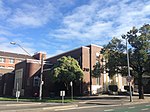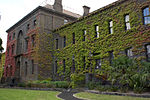350 St Kilda Road
1974 establishments in AustraliaApartment buildings in MelbourneResidential buildings completed in 1974Residential skyscrapers in AustraliaSt Kilda, Victoria ... and 2 more
Use Australian English from September 2015Victoria (Australia) building and structure stubs

350 St Kilda Road, currently known as St. James Apartments, is a 120 m high apartment building on St Kilda Road in Melbourne, Australia. It consists of 30 floors including three basement levels. It was originally built in 1974 for the Department of Defence. The low rise building next door with nine floors (including three basement levels) was also part of the original complex. Around 1,500 staff worked in the buildings. The tower was the tallest building outside the Central business district of Melbourne when constructed, and had unsurpassed views in all directions. The residential conversion was completed in 1998, and there were later renovations.
Excerpt from the Wikipedia article 350 St Kilda Road (License: CC BY-SA 3.0, Authors, Images).350 St Kilda Road
St Kilda Road, Melbourne Melbourne
Geographical coordinates (GPS) Address External links Nearby Places Show on map
Geographical coordinates (GPS)
| Latitude | Longitude |
|---|---|
| N -37.831137 ° | E 144.970101 ° |
Address
St James Apartments
St Kilda Road 350
3004 Melbourne, Melbourne
Victoria, Australia
Open on Google Maps










